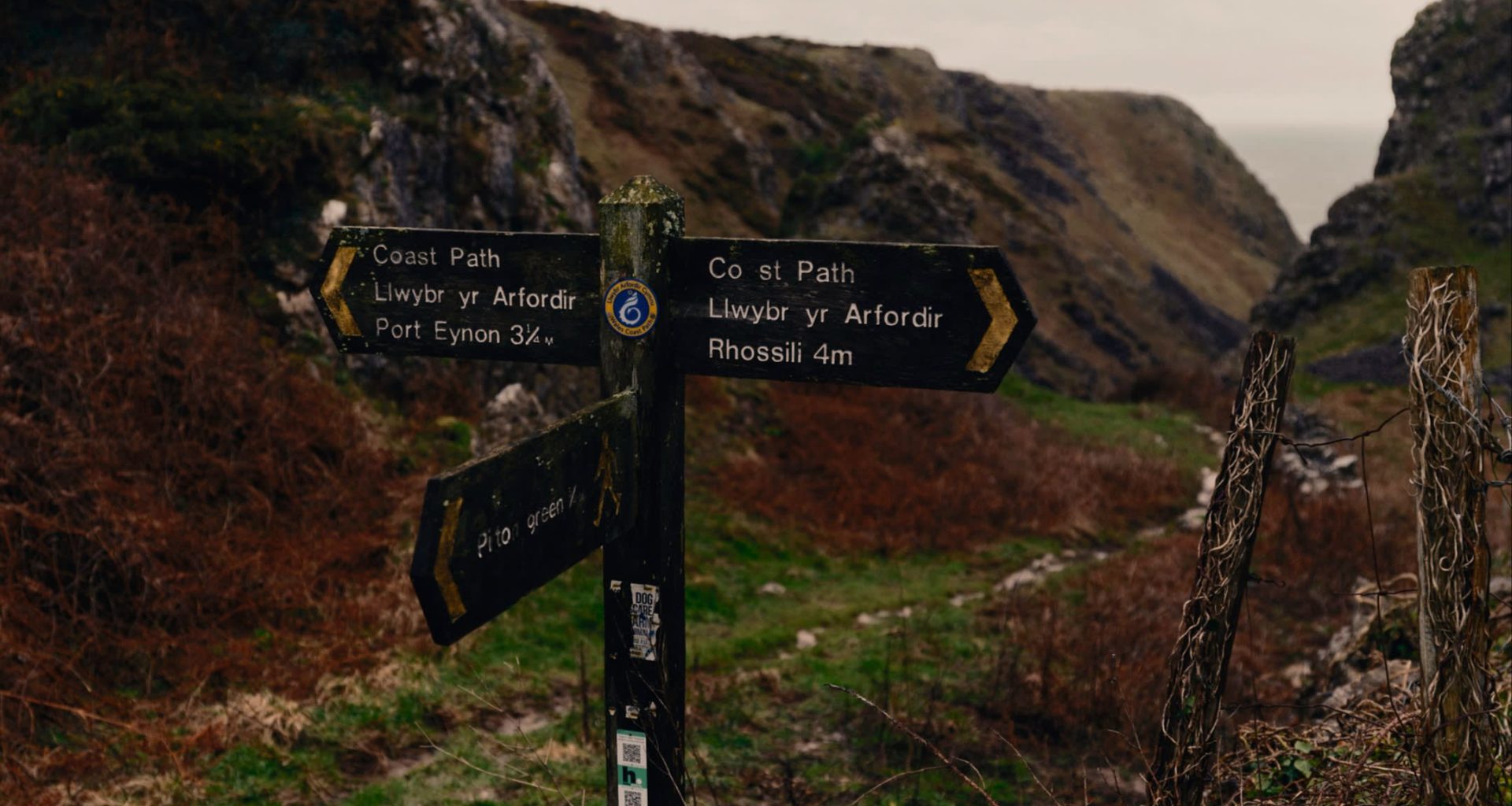Near the tip of the Gower Peninsula, four footpaths meet at a crossroads. A signpost provides distances for walkers in three directions: Rhossili 4 miles, Port Eynon 3¼ miles, Pilton Green ¾ mile. The fourth direction is unmarked. Here, a vague trail follows a drystone wall down towards the sea.
Travel in this direction is not encouraged. If you checked the internet, though, you’d know it offered an onward route, passable on foot at only the very lowest tides. Access is dependent on the whim of the sea, which functions like an opening and closing door.
Yet, just beyond that dead-end gully, at a dead end of the Gower (which, in some ways, is a dead end of western Europe), is a place implicated in a story of beginnings. Paviland Cave is the site of the oldest known ceremonial burial in western Europe. In the eyes of a few, it may also count among the continent’s first holy places. I set out to spend the night inside.
I was here researching my book On This Holy Island, which explores different kinds of British pilgrimage made across time. Pilgrimage is said to be in renaissance: last year 446,000 people completed the Camino de Santiago in northern Spain, more than double the total for 2013. Meanwhile the British Pilgrimage Trust and others are creating 21st-century routes that hark back to the heyday of medieval pilgrimage.


At the same time, the word “pilgrimage” itself is an elusive one, increasingly detached from formal religion to imply a journey of meaning anyone might define on their own terms. Ideas of “pilgrimage”, both prehistoric and modern, wisped around the entrance to Paviland Cave. Others had come before me.
The cave’s recorded history begins in earnest two centuries ago, with the arrival of Reverend William Buckland. Buckland was the first reader in geology at Oxford university: part of a generation for whom natural science was not in competition with religion, but rather a means of understanding the Almighty’s intentions, by scrutinising his creation.
Central to Buckland’s work was uncovering evidence of the Old Testament flood in Great Britain. In the Midlands he found pebbles that suggested an ancient deluge. In Yorkshire he found the bones of hyenas, elephants and rhinos — he initially surmised that floodwaters had carried them from the tropical regions of the world.

Buckland himself, meanwhile, was something of a Noah figure. He kept a menagerie of animals: pet hedgehogs, rats, a cobra, a crocodile and a turtle that took up residence in the fountain at his college. He is also said to have served mice on toast to his guests. By December 1822 he had learnt about a cave beside the Bristol Channel containing mysterious bones. This cavern was near inaccessible, necessitating a dangerous climb down a sea cliff to gain access.
Like Buckland, I didn’t have time to wait for low tide, so I’d called on the services of Andrew Price, a bushcraft instructor based on the Gower who had visited Paviland Cave many times. He arrived with a climbing rope slung over his shoulder and tins of chicken curry in a green backpack.


Vladimir Putin had been threatening nuclear war days before we met, and much of our conversation centred on the end times. Andrew seemed more prepared than most: he had iodine tablets and had once cached supplies in case of unrest following the “millennium bug”. Andrew explained that Paviland Cave would be a good place to live out a nuclear winter. You could catch fish there, and live off the wild cabbage growing on the cliffs.
From the crossroads we shimmied along a steep grassy ledge. The foghorn of a ship boomed from somewhere out in the sea. Soon our path reached the foot of a sheer rock face, which teetered high over the breaking waves of the Bristol Channel. Whatever Armageddon happened in the wider world, any slip would probably spell our own personal end times.
“It looks worse than it actually is,” said Andrew, uncoiling his rope. “Once you’re on the wall, try not to look down too much. It’s only a few simple moves.”
Andrew clambered up and, a minute later, beckoned me to follow. I moved slowly. Looking for a foothold, I half-spied the sea seething below my shoelaces. A rogue wave exploded like a bomb, bringing a little icicle-jab of fear to my heart. I concentrated on my fingertips, steadied myself as we inched round a corner. And there was the cave.

Paviland Cave had its mouth open to the sea, as if to ingest all the winds gusting in off the Atlantic. There were threads of fishing rope on the ground, and someone (“some vandal”, said Andrew) had recently carved runes into the wall. Other than that there was no sign of humanity.
“Given the history of this place, you’d expect it to feel a bit sinister,” Andrew said. “But I’ve never felt that. I’ve always felt that it was a comforting place to be. Like a church, almost.”
The cave was indeed about the dimensions of a small chapel. Most of all, it was loud: the mesmeric music of the sea echoed endlessly — sound waves breaking against the walls, murmuring in distant niches. Andrew said he had slept here before and woke up convinced he was hearing human voices. But there was no one there; it was just the waves.
It was in this same spot in 1823 that Buckland unearthed human remains. The bones had been coloured with red ochre, and there were periwinkle shells where a pocket might have been. These remains came to be known as “The Red Lady of Paviland”. In his book Reliquiae Diluvianae (“Relics of the Flood”) Buckland coldly describes his findings as “Portion of Female Skeleton, clearly postdiluvian”. Buckland believed the skeleton dated back two millennia — the redness of the bones suggested she was a Celtic prostitute. Yet in the midst of the human bones were remains of prehistoric animals — hyena and rhinoceros — whose presence was not as easily explained.
Buckland took the bones of the Red Lady back to Oxford (where they remain to this day, in the Museum of Natural History). The advent of carbon dating has since shown she is some 32,000 years older than Buckland first thought, and it has also transpired that she was the first fossil human skeleton uncovered by a scientist. Moreover, she was also a he.

By early evening, the winter sun was straining through passing clouds, and a few gulls yabbered above the cave mouth. Andrew set about making dinner. The climb up the cliff had brought us to the edge of the world. At one point a lonely bar of mobile phone reception drifted into range to pay us a visit, then disappeared. A few lights blinked in the distance out at sea — ships heading to Avonmouth maybe.
“Go in a straight line in that direction,” said Andrew, pointing out to sea with a spoon, “and you’ll eventually hit Brazil.”
Shortly before coming here, I had sought out Paviland Cave and the ‘Red Lady’: A Definitive Report (2000) — a giant black volume, embossed with golden bones. It was the distillation of a project undertaken by Professor Stephen Aldhouse-Green of the University of Wales, Newport. It placed the burial of the Red Lady, an otherwise healthy young man, during one of the milder periods of the ice age. Even during these balmier interludes, Britain could have represented a frontier of the habitable world. At their maximum extent glaciers would have rumbled not far from the mouth of Paviland Cave. A kingdom of ice extended north to the pole.
Sea levels would have been some 80 metres lower than the present day, so the cave would have looked out not at the tides, but across a broad valley where mammoth may have grazed. Paviland, then, was no sea cave but rather a crevice in a range that rose sharply from the Severn plains. This territory, Aldhouse-Green suggested with a flourish, might have been comparable in its remoteness to Arabia’s Empty Quarter travelled by Wilfred Thesiger in the 1940s. It might have been a cold boundary for humankind — an Ultima Thule.
There was the possibility the Red Lady had been a shaman, or perhaps an ancestor left in the cave to watch over the herds. But most striking of all was Aldhouse-Green’s speculation that Paviland Cave may have served as a sacred place for a period of more than 6,000 years. A range of items — carved objects, bones and worked ivory — suggested humans made consistent journeys here. People might have trudged through blizzards and drifts. Those journeys seemed to speak of a purpose for the cave beyond a place of shelter, or a base from which to go hunting.
Then, as now, it was somewhat inaccessible, albeit for different reasons. With that inaccessibility came a whisper of pilgrimage. Aldhouse-Green had passed away from Parkinsons some years before, but I had spoken on the phone to his widow, Miranda Aldhouse-Green, an emeritus professor of archaeology at Cardiff University, with whom his work had often overlapped.
“The cave was very much on the edge of the world,” she had told me. “And the whole idea of pilgrimage is the journey itself. It’s not just the point where you want to get to, but the whole effort is part of the pilgrimage.”
After dark we burrowed deep into our sleeping bags in the cave. My eyes calibrated to the gloom, watching subtle ripples of light playing on the ceiling above, the night sky reflecting on waves breaking ever closer to our beds. Andrew and I chatted before sleep. He noted the remains of the Red Lady did not include a skull; he thought the Palaeolithic nomads might have carried it away with them, as a relic of their companion.


Other theories suggested a storm could have stolen the skull from the cave — possibly the Bristol Channel floods of January 1607, which had claimed up to 2,000 lives (some people climbed church towers to survive). “There happened such an overflowing of waters,” wrote one observer, William Jones of Usk, “the like never in the memory of man hath ever been seen . . . If it had not been for the merciful promise of God, at the last dissolution of the world by water, by the sign of the rainbow, which is still shown to us: we might have verily believed this time had been the very hour of Christ’s coming.”
I woke up only once in the night, to go for a pee on the ledge outside the cave. It was low tide. Some of that drowned world where any ice age pilgrims might have trodden had emerged, barnacled and strewn with seaweed, shining weakly in the darkness.
The theory of Paviland Cave as a place of Palaeolithic pilgrimage has subsequently been contested — some say the evidence is absent, and developments in carbon dating have implied the cave did not necessarily mark the edge of habitable terrain. It might have just been a useful spot to leave a body. In the words of one academic I spoke to, “people want to believe all sorts of curious things about Paviland”.
But in any case, contemporary pilgrims still sometimes come to the cave, journeying to a place of origins, reconsecrating that ancient burial. Some time later, I contacted a Facebook group, the Swansea Pagan Moot, some of whose members had performed rituals in the cave and written poems in honour of the “Red Lady”. One — a man who insisted on being known as “the Kite” — had helped petition for the reburial of the 34,000-year-old bones.
“I feel something more needs to be done than having him stuck in a drawer in Oxford,” he had told me. “Our ancestors aren’t just some dead people who contributed to our DNA. These are the people who’ve stood where we stand — they are responsible for us being here.

“It’s our lack of a sense of history that has got us into the trouble that we are now. If you realise what has happened in the past, you realise global warming could happen again. Now the ice is melting in our gin and tonic. That’s why it still matters.”
The next morning, sunbeams streaked from the mouth of the Severn estuary. As Andrew and I ate breakfast, the outline of Devon emerged — the island of Lundy, the shore vanishing towards Cornwall. We left the cave and parted ways.
Eventually I reached my car and switched on the radio. A new UN climate report warned the planet was sleepwalking into environmental disaster, with sea levels on a trajectory to drown coastal cities from London to Lagos. Then again, it might not come to that. Later, a panel of experts was debating whether Putin would unleash strategic nuclear weapons if his regime fell — citing Louis XV’s expression of contempt for all that followed him: “Après moi, le déluge.”
Oliver Smith’s ‘On This Holy Island: A Modern Pilgrimage Across Britain’ is published by Bloomsbury Continuum on March 28
Details
Andrew Price runs a broad range of bushcraft courses on the Gower Peninsula — see dryadbushcraft.co.uk. Some of Wales’s (and Britain’s) best beaches are very close by, including Oxwich, Rhossili and Three Cliffs. visitwales.com has further information on the Gower
Five more places of pilgrimage in the UK

The Ridgeway Like Paviland Cave, the Ridgeway’s status as a route of prehistoric pilgrimage is uncertain. Nonetheless, modern walkers still find a certain resonance hiking this trackway across the Berkshire and Wiltshire downs — primarily because of the series of prehistoric sites it passes. Walking westwards on the 65km stretch from the Thames, you first come to the Uffington White Horse — thought to be the UK’s oldest hill figure — followed by the Neolithic tomb at Wayland’s Smithy. For some, the Santiago of this ancient Camino is the stone circle at Avebury — the Ridgeway National Trail ends a short distance away. nationaltrail.co.uk
Walsingham The sleepy Norfolk village of Walsingham became one of the great centres of Christian pilgrimage after the Virgin Mary appeared to a Saxon noblewoman here in 1061. Its priory became ruined after the Reformation and the village lapsed into relative obscurity — until an Anglican vicar re-established a new shrine in the 1920s and ’30s. In the 21st century, a new 290km route, the London to Walsingham Camino, has been established to bring walkers from the capital through the East Anglian countryside to this peaceful village. Alternatively, make a pilgrimage on the miniature steam trains that run from Wells-next-the-Sea. wwlr.co.uk
St Herbert’s Island Thousands of visitors make their way to the Northumbrian island of Lindisfarne — the sometime home of St Cuthbert. Fewer visit the tiny Cumbrian island where Cuthbert’s best friend St Herbert lived as a hermit. Canoers and kayakers can nonetheless make a freshwater pilgrimage to St Herbert’s Island — a wooded isle about five acres big in the middle of Derwentwater, where the seventh-century saint would have enjoyed views of Lakeland peaks. Step ashore and you can still find the ruins of his hermitage there today — little different to when William Wordsworth visited and described them as a “shapeless heap of stones”. keswick.org
Skirrid Mountains worldwide are a focus of pilgrimage, but perhaps the best example in the UK is the 486m-high Skirrid — an outlying peak in the Bannau Brycheiniog (Brecon Beacons) National Park. Known locally as “the Holy Mountain”, services were held at the now-ruined chapel on the summit until at least 1680. One story goes that Skirrid was shaped by an earthquake at the moment of Christ’s crucifixion; others say the landslip on its northern slope was formed when St Michael fought with the devil. Ever popular with hillwalkers, its slopes are still a place of pilgrimage today — local Anglicans scale its pulpit-like summit at Easter. The nearby Skirrid Inn claims to be Wales’s oldest, and has a cast of ghosts. nationaltrust.org.uk
Glastonbury Pilgrims of many kinds come to Glastonbury — Anglicans and Catholics, New Age priests and Arthurian questers. Whatever your belief system, the town’s striking geography lends itself to a pilgrimage on foot — start by climbing the long rise of Wearyall Hill before descending to the ruined arches of Glastonbury Abbey. Crowds make their way to the grassy summit of Glastonbury Tor for panoramic views of the Somerset Levels. Back on ground level, the far more peaceful Chalice Well Gardens, a sacred space where many cross-currents of faith converge, offers a place to rest. chalicewell.org.uk
Find out about our latest stories first — follow @FTWeekend on Instagram and X, and subscribe to our podcast Life & Art wherever you listen
Read More: World News | Entertainment News | Celeb News
FT










